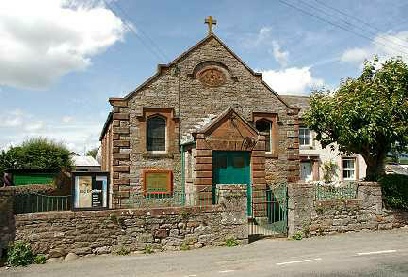History Ch 4
Bolton Methodist Chapel

The Methodist Chapel is situated on the road leading to Cliburn. It is one of the oldest Methodist Chapels in Westmorland. On the 10th of June 1820 a legal agreement was made between William Dent of Bolton, Yeomen and John Dent and several other persons:
Witnesses that in consideration of 10/- the said William Dent has conveyed to those of the second part, all that parcel of ground in the village of Bolton upon which a newly erected building used as the Chapel and Meeting House of the Wesleyan Methodists now stands on the north east back from the town street 44 feet, on the south west 47 feet, on the south east 37 feet, and 36 feet on the north west. Together with the said Chapel to hold services there…
There had been a Methodist Chapel at Kirkby Thore since 1798 but it was not until 1803 that Methodism was introduced into Bolton and by December of that year Bolton was listed in the circuit records as – one of the fifteen societies and as having paid a quarterage of 4/6d
The Dent family had always had close links with the parish church. Henry Dent was a churchwarden three times by 1800 and again in 1812.The family lived in the middle of the village At Gilflosh meaning valley swamp; known today as Elm house. Henry Dent was head of the household and he and his wife had six children. The family gave the Methodists a warm welcome and opened their house to the Methodist preachers. Gilflosh continued to be used for preaching until 1818 by which time the Brough Wesleyan Methodist circuit stretched from Renwick to Kirkby Stephen and from Hilton to Orton. Every Sunday a service was held in Bolton at 7pm.
It was through the effort and commitment of John Dent and other members of his family that Bolton had its own chapel in 1818 when John’s brother gave the site, the garden at Gilflosh and £30 towards the cost of building the Chapel, equal to about £1000 today.
A frequent visitor to the Chapel would have been Hodgson Casson a Wesleyan Minister born in Workington. In 1819 he came to serve in the newly amalgamated Brough and Penrith Circuit. He married Mary Dent John’s sister who in his autobiography described her as – an amiable female, of decided piety. Sadly the marriage was short lived as Mary died in 1823. Casson had a two year ministry in the area including a camp meeting that was held in a large field near to Bolton. A long cart served as a platform with Casson as the principal speaker.
In 1833 a Sunday school was started in the Chapel with John Dent as Superintendent. In 1861 the average attendance was 45 in the morning and 53 in the afternoon. Band of Hope meetings were also held in the Chapel. The Band of Hope was first proposed by Jabez Tunnicliffe a Baptist Minister from Leeds. The idea came about after he witnessed the death of a young man whose death was caused by alcohol. The Band of Hope became an advocate for the total abstinence from alcohol and in 1847 with other Temperance workers they founded an objective to teach children the importance and principles of teetotalism. The Band of Hope soon became a national organisation and meetings were held in churches throughout the country.
Methodism in Bolton was much affected by National events. On the death of John Wesley the Methodist Conference of 100 Methodist Ministers assumed his great power, but it was felt that the conference never allowed the voice of the layman to be heard and in 1827 a decision of a district meeting was overturned by conference and many members left the Wesleyan church. There was more discontent voiced when conference proposed a training school for ministers with Jabez Bunting as principal.
Reform was demanded when over a hundred delegates gathered in Sheffield in July 1835 all having some grievance against the conference party of the Wesleyan Church. John Dent went to represent those demanding reform in the Appleby Circuit but conference refused to receive the delegates. The delegates were determined to continue with their association and broke away from the parent body, calling themselves the Wesleyan Methodist Association holding their first annual assembly in Manchester in August 1836. Wesleyan Association Circuits were formed and a new branch of Methodism came into being. All the Methodists at Bolton withdrew from the Wesleyan Church.
At this time a great difficulty arose because Bolton’s Methodist Chapel belonged to the Wesleyans and the new Methodists were not allowed to use it for their services. Gilflosh was opened up once more to be used for services and for four years the chapel stood unused because the Wesleyans stood firm in their refusal to allow the new Methodists to use the Chapel. This must have been infuriating to the Dent family because they had provided the land and monies for the Chapel to be built in the first place. It was not until 1840 when the Chapel was falling into disrepair that the Wesleyans accepted the offer of payment of the cost of the building beyond the original subscriptions. From then on Methodism was able to progress in the village.
In 1926 a major renovation took place; the building was heightened and the interior redesigned and refurbished. Thomas Bert Irving from Morland did the stone work and Joseph Dent of Warcop the wood work. The stained glass window was fitted at this time and the chapel was reopened by Mrs G J Williams the Mayoress of Appleby. Although the congregation is small it still meets in this little chapel every week.
